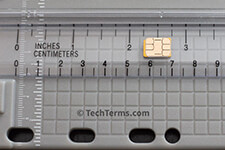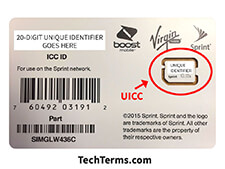UICC
Stands for "Universal Integrated Circuit Card." A UICC is a "smart card" designed to operate with 3G and 4G wireless technologies, including LTE. It can be used for multiple applications, but is commonly used as a SIM card in mobile phones. UICCs have mostly replaced ICCs (Integrated Circuit Cards), which were used with 2G and early 3G systems.
A UICC is a tiny card, smaller than a thumbnail, that includes an integrated circuit. This circuit contains a processor, non-volatile memory (NVRAM), ROM, and RAM. Each card has a unique identifier that is used to identify a device on a cellular network. The card may also store data, such as contacts that have been saved by the user. While there is no standard storage capacity for UICCs, they commonly have at least 256 kilobytes of storage and may exceed one gigabyte.
UICCs are "universal" since a single card supports multiple applications and therefore multiple cellular networks. Examples include USIM (Universal Subscriber Identity Module) for GSM networks, CSIM (CDMA Subscriber Identity Module) for CDMA networks, and ISIM (IP Multimedia Services Identity Module) for UMTS networks. The universal nature of UICCs allow them to work with various mobile networks around the world.
NOTE: In order to use a UICC, the card's unique identifier (the ICC ID) must be registered and activated with a mobile service provider. Removing the card from a smartphone or other cellular device will make the device unrecognizable on the network. In most cases, if you insert the UICC card in another device, it will be automatically be recognized and usable on the network.
 Test Your Knowledge
Test Your Knowledge
